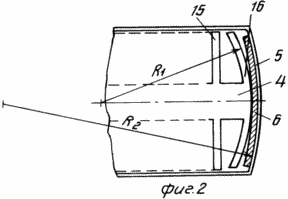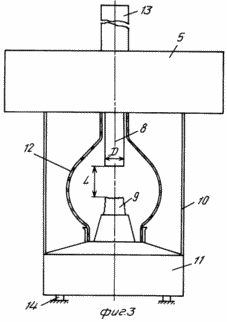| section Home
Production, Amateur Radio amateur Model aircraft, rocket- Useful, entertaining |
Stealth master
Electronics Physics Technologies invention |
space Mystery
Earth Mysteries Secrets of the Ocean Stealth section Map |
|
| Use of material is permitted for reference (for websites - hyperlinks) | |||
Navigation: => |
Home / Products Patents / In the section of the catalog / back / |
|
INVENTION
Russian Federation Patent RU2065645
![]()
thermoelectric generator
Name of the inventor: Shalaev NV .; Kopaev VG
The name of the patentee: Nikolai Shalaev
Address for correspondence: 1993.02.03
Starting date of the patent:
Use: in thermoelectric generators using liquid or gaseous fuel. The inventive installation consists of a heat exchanger unit with channels for coolant thermopiles located on the faces of the block, and cooling radiators adjoining batteries. The assembly is covered with an interference fit shell made of a resilient material. Central radiator portion protrudes with respect to its extreme zones. Between these thin wall sheath portion and clamped leaf spring which flexes during assembly of the device and produces a constant force of compression of its elements. Preferably the ratio of shell thickness to the thickness of the leaf spring to select the range 1: 1.25 - 1: 3.
DESCRIPTION OF THE INVENTION
The invention relates to the field of thermoelectricity, and can be used in thermoelectric generators, operating at an organic liquid or gaseous fuel, preferably using heat generated by fuel combustion burner.
Known thermoelectric generator comprising a heat exchange unit disposed above the heat source, the thermoelectric battery arranged on the surfaces of the heat exchange unit, the heat sink and the elements pressing [1] System In a thermoelectric generator elements nip formed in a plurality of tie shaped studs with coil springs, uniformly distributed over the perimeter of thermopiles.
The disadvantage of the thermoelectric generator is the complexity of the structure, due to a significant number of elements of the pressing and substantial Leakage and heat, defined by the presence of the auxiliary membranes connecting the hot heat exchanger to the heat sink system.
The closest the technical essence and achieved result to the described generator is a thermoelectric generator comprising an assembly comprising a heat exchange unit on the faces of which there are thermoelectric battery, with placed on them radiators, compression assembly system of elements and the supporting elements [2] In a thermoelectric generator system compression is designed as clamping rings, seals, clamps on the number of thermoelectric batteries and coupling bolts.
The disadvantage of a thermoelectric generator design complexity clamping system comprising a large number of different elements, which are joined quite complex manner with thermoelectric batteries and radiators, which increases the weight of the generator and increasing its cost.
The invention is directed to a thermoelectric generator of weight reduction and the reduction of its cost due to simplification of the limit clamping system.
To achieve this goal in a thermoelectric generator, comprising an assembly comprising a heat exchange unit, on the faces which are arranged thermoelectric battery with placed on them radiators elements compression system assembly and support elements, the compression system is designed as a shell with an interference fit covering assembly, and at least one leaf spring clamped between the inner wall of the shell and the central portion of the radiator, which protrudes in relation to its marginal zones, whereby preferably a closed shell be made of a resilient material, such as stainless steel, the ratio of shell thickness to the thickness of the leaf spring selected in range 1: 1.25 to 1: 3, radiator portion adjacent the leaf spring, made as a curved surface or a stepped surface, decreasing from the central zone to the marginal zones of the radiator; leaf springs placed between each radiator and a thin-walled shell; support members with the ability to perform height regulation.
The inventive thermoelectric generators provide the maximum simplification of the clamping system, which in the limit can contain only two elements of simple shape. Closed thin-walled shell with interference covers assembly, consisting of a heat exchange unit, thermoelectric batteries and radiators, with the leaf spring is clamped between the inner wall of the shell and protruding central portion of the radiator, providing a reliable clamping thermopiles to a heat exchange unit and the cooling radiators for the thermoelectric batteries due to the efforts of membranes and interference forces generated during bending plane of the spring. Implementation of the radiator with a protruding central portion, which is based on the leaf spring in its jamming, ensures bending plane of the spring, creating the required clamping force build elements. The projecting portion is preferably carried out in either the form of an arcuate surface that provides a uniform bending of the leaf spring preload in a thin-walled shell or as a stepped surface, gradually decreasing from the center towards the edge zones, which are easier to manufacture. Thin-walled shell preferably made of elastic materials such as stainless steel. Art. steels Art. 10, Art. And 20 m. P. The thickness of the shell must be selected within ![]() 1 0.3 0.5 mm, since in such thicknesses provide sufficient rigidity of the shell and the possibility of its bending during assembly. The experiments revealed that the optimum range of the thickness of the leaf spring
1 0.3 0.5 mm, since in such thicknesses provide sufficient rigidity of the shell and the possibility of its bending during assembly. The experiments revealed that the optimum range of the thickness of the leaf spring ![]() 2 0.6 and 0.8 mm, respectively, the range of optimal shell thickness relationship to the thickness of the plate:
2 0.6 and 0.8 mm, respectively, the range of optimal shell thickness relationship to the thickness of the plate: ![]() 1 /
1 / ![]() Feb. 1: 1.25 1: 3.
Feb. 1: 1.25 1: 3.
When used in a generator large number of thermopiles large area it is advisable to place the leaf springs between each radiator and a thin-walled shell, as this will increase the clamping force. To allow movement of the thin-walled shell with respect to the radiator reference generator elements may be made to be adjustable in height, for example in the form of annular elements and screws with tapered ends.
 |
 |
 |
The accompanying drawings show: Fig. 1 a cross-sectional view of a thermoelectric generator, top view; FIG. 2 of the clamping system; FIG. 3 perspective view of a thermoelectric generator, side view. Described thermoelectric generator comprises: one thermoelectric battery, 2 a heat exchange unit 3 feeds the heat exchange unit, 4 - cooling radiators 5 Thin-walled closed shell, 6 leaf spring 7 Insulation 8 teplopriemny element (adjacent to the heat exchange unit 2), 9 wick burner, support members 10, 11 - container for liquid organic fuel steklolampy 12, 13 exhaust pipe, 14 feet. Thermopiles elements 1 are made of high-performance semiconductor materials such as lead telluride. The heat exchange unit 2 is made of a highly conducting materials such as aluminum alloys, cast iron, etc. material, and has a system of three vertical channels for passing the combustion products. Cooling radiator plate 4 is usually carried out with a thickness of 1 mm plates 1, which are usually made of aluminum or its alloys. Radiator 4 operates with a projecting central portion (see. Fig. 2). 5, the thin-walled sheath with an interference fit assembly covers all the elements 1, 2, 4. |
Described thermoelectric generator operates as follows. After assembly of all the elements of the generator 6 the leaf spring is bent and clamped by creating a constant pressing force to the thermoelectric battery 1 and the heat exchange unit 2 to the radiator 4. After cooling the liquid fuel combustion burner for combustion wick 9 and the heated air through the channels teplopriemnogo member 8 comes in the heat exchange unit 2 and transmit heat the walls of the channel 3. The heat flow through the elements of thermoelectric batteries 1, creating a temperature difference to them, due to the Seebeck effect, thermoelectric power is generated and the payload (in the drawing is not specified) useful electrical energy is supplied. The waste heat is supplied to the cooling radiator 4 and subsequently discharges into the environment. During heating generator changes the mutual arrangement of its different elements, but thin-walled shell 5 and a curved leaf spring 6 provides constancy assembly clamping force of the elements 1, 2, 4 during operation under conditions of repeated temperature cycling.
The inventive thermoelectric generator may be fabricated from conventional materials without the need for special technology.
Prototypes of the claimed thermoelectric generators were manufactured at RPC "Pravdinsky" (pos. Pravdinsky, Pushkin district, Moscow region.) And have been successfully tested in a multiple (thousands of thermal cycles) thermal cycling.
In comparison with known thermoelectric generators using a gaseous or liquid organic fuels in the inventive thermoelectric generator able to simplify the construction of the pressing system, which has reduced weight (more than 15%) and reduce the cost of the generator, since the simplified design and manufacturing technology.
CLAIM
1. A thermoelectric generator comprising an assembly comprising a heat exchange unit, which are located on the faces of the thermoelectric battery with radiators placed on them, the compression assembly system elements and support elements, wherein the compression system is formed as a shell with an interference fit around the perimeter, embracing assembly and at least one leaf spring clamped between the inner wall of the shell and the central portion of the radiator, which protrudes in relation to its marginal zones.
2. Generator according to claim 1, characterized in that the sheath is made of a resilient material.
3. Generator according to claim 2, characterized in that the shell is made of stainless steel.
4. Generator according to claim 1, characterized in that the ratio of shell thickness to the thickness of the leaf spring is 1: 1.25 1: 3.
5. Generator according to claim 1, characterized in that the radiator portion adjacent to the plate spring is formed as a curved surface.
6. Generator according to claim 1, characterized in that the radiator portion adjacent to the plate spring is formed as a stepped surface, decreasing from the central zone.
7. Generator according to claim 1. characterized in that the leaf springs arranged between each radiator and the shell.
8. Generator according to claim 1, characterized in that the support elements are arranged to regulate the height.
print version
Publication date 13.01.2007gg




Comments
Commenting, keep in mind that the content and the tone of your messages can hurt the feelings of real people, show respect and tolerance to his interlocutors, even if you do not share their opinion, your behavior in terms of freedom of speech and anonymity offered by the Internet, is changing not only virtual, but real world. All comments are hidden from the index, spam control.